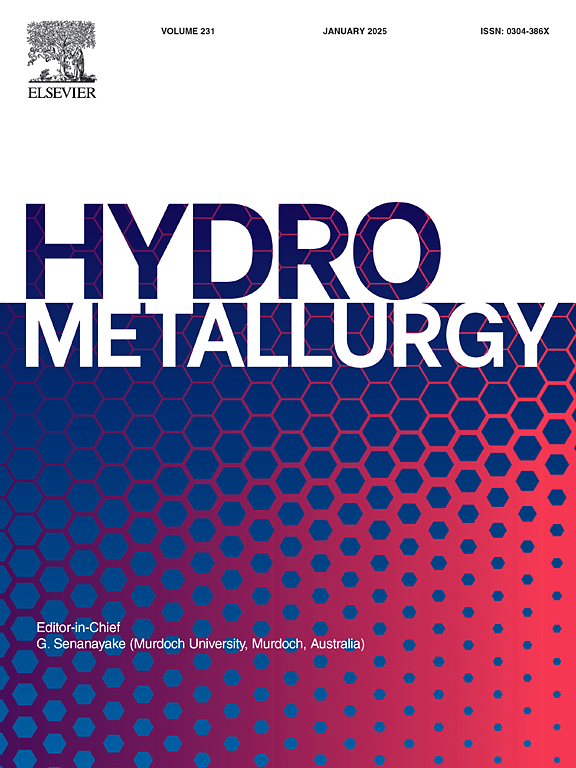用过氧化氢氧化沉淀法从溶液中分离铈:反应机理
IF 4.8
2区 材料科学
Q1 METALLURGY & METALLURGICAL ENGINEERING
引用次数: 0
摘要
研究人员在间歇式反应器中研究了通过过氧化氢氧化沉淀从溶液中去除铈的方法,以确定最大程度去除铈的最佳条件。试验是在 pH 值为 2、3、4 和 5 的环境温度下进行的,分别采用了精确的化学计量要求以及 30% 和 50% 的过量。结果发现,与文献中大多数氧化剂通常直接形成 Ce(OH)4 的情况不同,与过氧化氢的反应是通过一种可转移的氢氧化铈进行的,温度升高,转化率增加。对两种途径的标准反应自由能进行了计算。为了更好地理解这一过程,在低 pH 值条件下,通过解耦方法分别研究了 Ce(III) 氧化成 Ce(IV) 和 Ce(OH)4 沉淀的过程,并提出了每个过程的反应机制。研究发现,Ce(III) 氧化反应是限速步骤,而 Ce(IV) 沉淀则是快速定量反应。在 pH 值为 3-5 的范围内,Ce 的去除率在 80% 到 95% 之间,具体取决于过氧化氢的过量。在通过氧化沉淀进行除铈步骤后,发现需要在 80 °C 和 pH 值为 2.5 的条件下进行 2 小时的老化阶段,以完成过氧化氢铈向更稳定的氢氧化铈的转变,并分解任何残留的 H2O2。本文章由计算机程序翻译,如有差异,请以英文原文为准。
Separation of cerium from solution by oxidative precipitation with hydrogen peroxide: The reaction mechanism
Cerium removal from solution via oxidative precipitation with hydrogen peroxide was investigated in a batch reactor to identify optimum conditions for maximum Ce removal. Tests were performed under ambient temperature at pH 2, 3, 4 and 5, using the exact stoichiometric requirement and 30 % and 50 % excess, respectively. It was found that, unlike the usual direct Ce(OH)4 formation presented in the literature for most oxidants, the reaction with hydrogen peroxide proceeded via a metastable ceric hydroxide, with conversion rates increased by increasing temperature. Standard free energies of reaction were calculated for both routes. To better understand the process, the oxidation of Ce(III) to Ce(IV) and the precipitation of Ce(OH)4 were studied separately via a decoupled approach at low pH and reaction mechanisms for each process were proposed. The Ce(III) oxidation reaction was identified as the rate-limiting step, whereas Ce(IV) precipitation was fast and quantitative. In the pH range of 3–5, Ce removal extents varied between 80 and 95 %, depending on the hydrogen peroxide excess. Following the Ce removal step via oxidative precipitation, it was found that a 2 h ageing stage at 80 °C and pH 2.5 was required to complete the transition of cerium hydroxy-peroxide to the more stable ceric hydroxide and decompose any residual H2O2.
求助全文
通过发布文献求助,成功后即可免费获取论文全文。
去求助
来源期刊

Hydrometallurgy
工程技术-冶金工程
CiteScore
9.50
自引率
6.40%
发文量
144
审稿时长
3.4 months
期刊介绍:
Hydrometallurgy aims to compile studies on novel processes, process design, chemistry, modelling, control, economics and interfaces between unit operations, and to provide a forum for discussions on case histories and operational difficulties.
Topics covered include: leaching of metal values by chemical reagents or bacterial action at ambient or elevated pressures and temperatures; separation of solids from leach liquors; removal of impurities and recovery of metal values by precipitation, ion exchange, solvent extraction, gaseous reduction, cementation, electro-winning and electro-refining; pre-treatment of ores by roasting or chemical treatments such as halogenation or reduction; recycling of reagents and treatment of effluents.
 求助内容:
求助内容: 应助结果提醒方式:
应助结果提醒方式:


